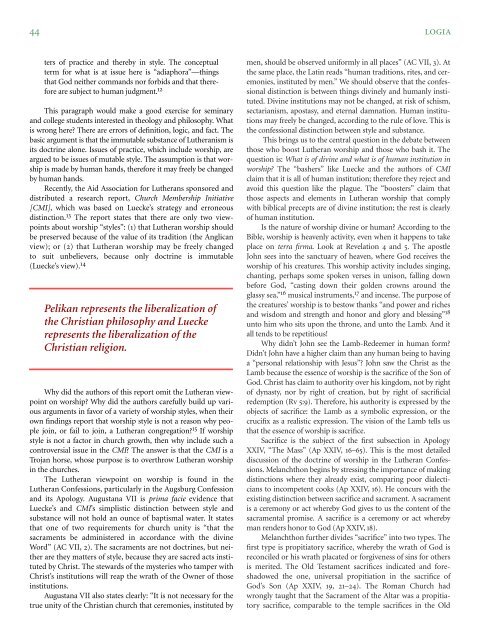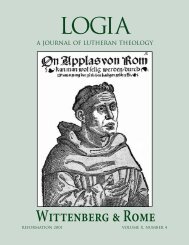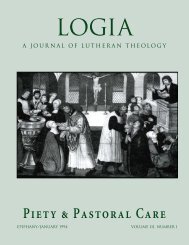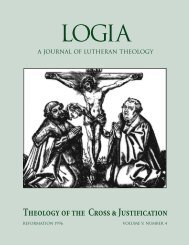04-2 Hermeneutics.pdf
04-2 Hermeneutics.pdf
04-2 Hermeneutics.pdf
- No tags were found...
Create successful ePaper yourself
Turn your PDF publications into a flip-book with our unique Google optimized e-Paper software.
44 LOGIAters of practice and thereby in style. The conceptualterm for what is at issue here is “adiaphora”—thingsthat God neither commands nor forbids and that thereforeare subject to human judgment. 12This paragraph would make a good exercise for seminaryand college students interested in theology and philosophy. Whatis wrong here? There are errors of definition, logic, and fact. Thebasic argument is that the immutable substance of Lutheranism isits doctrine alone. Issues of practice, which include worship, areargued to be issues of mutable style. The assumption is that worshipis made by human hands, therefore it may freely be changedby human hands.Recently, the Aid Association for Lutherans sponsored anddistributed a research report, Church Membership Initiative[CMI], which was based on Luecke’s strategy and erroneousdistinction. 13 The report states that there are only two viewpointsabout worship “styles”: (1) that Lutheran worship shouldbe preserved because of the value of its tradition (the Anglicanview); or (2) that Lutheran worship may be freely changedto suit unbelievers, because only doctrine is immutable(Luecke’s view). 14Pelikan represents the liberalization ofthe Christian philosophy and Lueckerepresents the liberalization of theChristian religion.nbWhy did the authors of this report omit the Lutheran viewpointon worship? Why did the authors carefully build up variousarguments in favor of a variety of worship styles, when theirown findings report that worship style is not a reason why peoplejoin, or fail to join, a Lutheran congregation? 15 If worshipstyle is not a factor in church growth, then why include such acontroversial issue in the CMI? The answer is that the CMI is aTrojan horse, whose purpose is to overthrow Lutheran worshipin the churches.The Lutheran viewpoint on worship is found in theLutheran Confessions, particularly in the Augsburg Confessionand its Apology. Augustana VII is prima facie evidence thatLuecke’s and CMI’s simplistic distinction between style andsubstance will not hold an ounce of baptismal water. It statesthat one of two requirements for church unity is “that thesacraments be administered in accordance with the divineWord” (AC VII, 2). The sacraments are not doctrines, but neitherare they matters of style, because they are sacred acts institutedby Christ. The stewards of the mysteries who tamper withChrist’s institutions will reap the wrath of the Owner of thoseinstitutions.Augustana VII also states clearly: “It is not necessary for thetrue unity of the Christian church that ceremonies, instituted bymen, should be observed uniformly in all places” (AC VII, 3). Atthe same place, the Latin reads “human traditions, rites, and ceremonies,instituted by men.” We should observe that the confessionaldistinction is between things divinely and humanly instituted.Divine institutions may not be changed, at risk of schism,sectarianism, apostasy, and eternal damnation. Human institutionsmay freely be changed, according to the rule of love. This isthe confessional distinction between style and substance.This brings us to the central question in the debate betweenthose who boost Lutheran worship and those who bash it. Thequestion is: What is of divine and what is of human institution inworship? The “bashers” like Luecke and the authors of CMIclaim that it is all of human institution; therefore they reject andavoid this question like the plague. The “boosters” claim thatthose aspects and elements in Lutheran worship that complywith biblical precepts are of divine institution; the rest is clearlyof human institution.Is the nature of worship divine or human? According to theBible, worship is heavenly activity, even when it happens to takeplace on terra firma. Look at Revelation 4 and 5. The apostleJohn sees into the sanctuary of heaven, where God receives theworship of his creatures. This worship activity includes singing,chanting, perhaps some spoken verses in unison, falling downbefore God, “casting down their golden crowns around theglassy sea,” 16 musical instruments, 17 and incense. The purpose ofthe creatures’ worship is to bestow thanks “and power and richesand wisdom and strength and honor and glory and blessing” 18unto him who sits upon the throne, and unto the Lamb. And itall tends to be repetitious!Why didn’t John see the Lamb-Redeemer in human form?Didn’t John have a higher claim than any human being to havinga “personal relationship with Jesus”? John saw the Christ as theLamb because the essence of worship is the sacrifice of the Son ofGod. Christ has claim to authority over his kingdom, not by rightof dynasty, nor by right of creation, but by right of sacrificialredemption (Rv 5:9). Therefore, his authority is expressed by theobjects of sacrifice: the Lamb as a symbolic expression, or thecrucifix as a realistic expression. The vision of the Lamb tells usthat the essence of worship is sacrifice.Sacrifice is the subject of the first subsection in ApologyXXIV, “The Mass” (Ap XXIV, 16–65). This is the most detaileddiscussion of the doctrine of worship in the Lutheran Confessions.Melanchthon begins by stressing the importance of makingdistinctions where they already exist, comparing poor dialecticiansto incompetent cooks (Ap XXIV, 16). He concurs with theexisting distinction between sacrifice and sacrament. A sacramentis a ceremony or act whereby God gives to us the content of thesacramental promise. A sacrifice is a ceremony or act wherebyman renders honor to God (Ap XXIV, 18).Melanchthon further divides “sacrifice” into two types. Thefirst type is propitiatory sacrifice, whereby the wrath of God isreconciled or his wrath placated or forgiveness of sins for othersis merited. The Old Testament sacrifices indicated and foreshadowedthe one, universal propitiation in the sacrifice ofGod’s Son (Ap XXIV, 19, 21–24). The Roman Church hadwrongly taught that the Sacrament of the Altar was a propitiatorysacrifice, comparable to the temple sacrifices in the Old
















